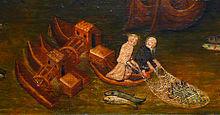Ship mill

A ship mill, more commonly known as a boat mill, is a type of
Technology


Between barge and boat well is the
Floating allows the mill to operate with the same power despite changing water levels. The efficiency of the mill can at best match a standard undershot mill. Ship mills could potentially run full-time, good for tasks that demanded constant power.
Ship mills could be drawn to shore (due to shipping, rafting, ice) when needed. In central Europe ship mills were, as most water and wind mills, owned by lords or monasteries. Ship mills in Central Europe have not remained; after the advent of riverboat traffic, they became a hindrance. Ship mills last about fifty years.
History
In the 537 siege of Rome, supplies were interrupted by the Goths from providing the population with vital flour from the surrounding water mills. Also, the aqueducts that supplied Rome with water and some cities which had water-driven mills could no longer work. The solution devised by the Eastern Roman general Belisarius was the "reverse principle of a water mill" - the ship mills, which were anchored on the Tiber river around Rome.[2]
It was a type of watermill powered by
Ship mills were developed in the
From the late 10th century onwards, there was an expansion of milling in Northern Europe.[4] Since then, ship mills were common in much of Europe until the 19th century, with a few of them surviving today.[7]
The German terms "Schiffsmühle" or "Schiffmühle" are used according to local language preferences.
Geographical spread of ship mills


Ship mills were used on most major rivers in Europe.
- Elbe - until 1911
- Rhine: Strasbourg and Mainz - 9th–12th centuries
- Danube: Regensburg - 1493 mentioned; Vienna at Kaisermühlen (Old Danube), or Orth an der Donau (in Lower Austria)
- Mur: Austria, Slovenia, Croatia and Hungary
- Weser: Minden - 1326 first mentioned
- Tiber: Rome
- Seine: Paris, near or under the bridges
- Marne, Garonne, Loire, in France, until 1850
- Kura: Tbilisi, since at least the 10th century until 1920-30s.
- Po: Mantua province from 851 until 1945.
Tourism
There are some replicas of ship mills:
- working ship mill on the Weser river, in Minden (North Rhine-Westphalia, Germany,
- ship mill on the Mulde river, in Grimma-Höfgen, Saxony, Germany, in the hollow, since 1992 all year on the river, the water is pumped,
- working ship mill on the Danube, in Orth an der Donau, Austria,
- working ship mill on the Danube, in Ráckeve, Hungary,
- ship mill on the Mur river, in Mureck, Styria, Austria,
- ship mill on the Mur river, in Verzej, Slovenia
- ship mill on the Mur river, in Sveti Martin na Muri, Croatia.
There are also ship mills on land, as monuments:
- In Magdeburg (Germany), on the banks of the Elbe. There were once up to 23 pieces.
- In Bad Düben (Germany) in the castle grounds, there is the mountain ship mill, formerly with the grain as crushed.
-
A ship mill in Magdeburg, Germany
-
A ship mill in Höfgen at Grimma, Germany
-
A ship mill on theVerzej, Slovenia
-
A ship mill replica on theMur River at Mursko Središće, Croatia
Notes
- ^ "Deutsches Museum: Ship Mill", The Deutsches Museum's collections: Ship Mill (Model), 1819 (see below: External links).
- ^ a b Wikander 2000, p. 383
- ^ Wikander 2000, p. 384
- ^ ISBN 9781317761570.
- ^ a b Hill 1984, p. 137
- ^ Harverson 1993, p. 176, fn. 31
- ^ Forbes 1965, pp. 105f.
References
- Forbes, R. J. (1965), Studies in Ancient Technology, vol. 2 (2nd ed.), Leiden: E. J. Brill, pp. 105f.
- Harverson, Michael (1993), "Watermills in Iran", Iran, 31: 149–177, doi:10.2307/4299897
- "Deutsches Museum: Ship Mill", The Deutsches Museum's collections: Ship Mill (Model), 1819 (see below: External links).
- Heinrich Ernst: Anweisung zum praktischen Mühlenbau. Leipzig 1805.
- Hill, Donald (1984), "Information on Engineering in the Works of Muslim Geographers", History of Technology, 9: 127–142
- Daniela Gräf, "Boat Mills in Europe from Medieval to Modern Times". Veröffentlichungen des Landesamtes für Archäologie, Sachsen 51, 2006.
- J. Mager, G. Meißner, W. Orf: Die Kulturgeschichte der Mühlen ("The Cultural History of Mills"), Leipzig 1988.
- Adam Meltzer: Mühlenbaukunst ("Mill Architecture"), Merseburg 1805.
- "Wien - 22. Bezirk/Donaustadt", Wien.gv.at, 2008, webpage (15 subpages): Wien.gv.at-donaustadt (in German).
- ISBN 90-04-11123-9
External links
- Historische Schiffsmühle, Magdeburg (Sachsen-Anhalt/Germany ...Historical ship mill, Magdeburg (Saxony-Anhalt/Germany) - photos and videos tagged with ship mill, webpage: flickr.com-9676.
- "Deutsches Museum: Ship Mill", The Deutsches Museum's collections: Ship Mill (Model), 1819, webpage: mill/ deutsches-museum.de-ship-mill[permanent dead link] (English).
German webpages
- www.schiffmuehle.de Die Schiffmühle in Minden.
- www.schiffsmuehle.at Die Murecker Schiffsmühle auf der Mur.
- www.schiffmuehle.at Die Schiffmühle in Orth.
- www.duebener-heide.de/heimatverein/schiffm.html Bergschiffmühle in Bad Düben.
- www.deutsche-muehlen.de DGM.
- www.fan-nds.de Archäologische Funde.
- Schiffmühle in Slowakia Die Schiffsmühle in Kolarovo.
- www.earthlights.de-minden Image gallery of ship mill in Minden.




